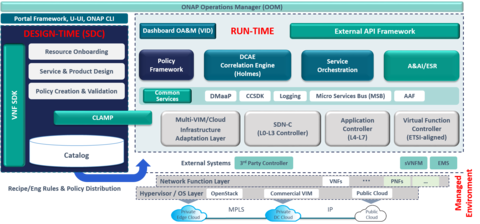Verizon has joined the Open Network Automation Platform (ONAP) project as a Platinum member, a move that reflects the service provider's desire to drive industry harmony around network virtualization and automation.
ONAP brings together several global carriers and vendors to build an automation and orchestration platform to transform the service delivery lifecycle for network, cable and cloud providers.
In becoming part of the ONAP community, Verizon said it expects achieve several goals:
Improving network functions: Simplify and accelerate onboarding of network functions while expanding interoperability with other SDN ecosystems.
Network tools: Gain greater agility in network management, service creation and provisioning to best meet customer needs.
Standardizing network elements: The telco also wants to drive reference standards to vendors and partners for consistent deployment of their network services in the Verizon network.
RELATED: ONAP prepares for Beijing release, sets focus on applications, operations
Like other large providers, Verizon has been implementing virtualization throughout its network. The service provider has been an early mover on next-generation SDN-related services like SD-WAN, for example.

“Verizon is very on its way with virtualization and delivering the new features,” said Srini Kalapala, VP of global technology and supplier strategy for Verizon. “Within our enterprise side, we’ve launched an SD-WAN service and we’ve been continually delivering new features there.”
Previously, Verizon had not openly embraced ONAP.
During FierceWireless “Telecom Transformation” event last October, Verizon said that its approach SDN, NVF and service virtualization has largely followed ETSI’s specifications for MANO.
At that time, the service provider platform and has made some of its own tweaks to the platform, which it has then pushed on to its vendors and partners so they can support it.
Accelerating service delivery, automation
A big focus of Verizon’s adoption of ONAP is to enable network automation and accelerate service creation times.
Network automation, while still a nascent topic, supports a variety of functions, including network mapping and device discovery as well as others like provisioning virtual network resources.
Network automation will also play a role in provisioning virtual network resources as well as SDN network virtualization and orchestration, enabling auto provisioning of virtual network functions and services.

While the adoption of ONAP is gaining momentum, Verizon found several of its vendor partners had fragmented approaches, which made it more challenging for the telco to procure virtual network functions (VNFs).
“One of the things we have noticed as we have been on this path is the variability in this industry especially in relation to virtual network functions and the vendors,” Kalapala said. “The vendors have to customize that for our own environment and for other ONAP members and customers and the negative of that is slowness in delivering new features.”
By joining ONAP, which had already been supported by large carriers such as AT&T, Orange, Bell Canada and others, Verizon could also help to drive common ground for specifications with the broader vendor community.
“We saw that ONAP was gaining traction in the industry with big carriers behind them,” Kalapala said. “Our view was that if we were to join ONAP, we could influence the vendor community and others to create an open source-based counter and put some scale behind it.”
Kalapala added that ONAP was aligned with “goals we have which is full automation and delivering advanced capabilities.”
Simplified optical network
To support its underlying core wireline network, the service provider has been equipping it with SDN elements.
The service provider is moving to deploy an open edge-based connectivity network and tying its optical and IP to the orchestration layer.
In the optical network. Verizon could use virtualization to ensure the delivery of latency networking services for example.
“If I want to offer a low latency network service, I need to ensure that we can guarantee the transport level performance and the application layer level,” Kalapala said. “For us to deliver these future capabilities, we have to automate top to bottom and that’s a view we’re taking.”
At the lower layers of the network, Verizon will separate the control plane and the data plane and tie the control plane into its orchestration pieces. At the top application layer, the carrier will virtualize the functions and stitching all of it to the orchestration layer.
“We will then tie all of this with analytics and data to both fully automate with closed loop feedback mechanisms in place,” Kalapala said.
Driving intercarrier interoperability
ONAP is set on driving interoperability in two ways: for the vendors and the carriers.
In November, ONAP put out its first platform release, ONAP Amsterdam, which focuses on providing a unified architecture for closed-loop network automation.

“When a release comes out like Amsterdam, things have already been implemented within the software that by default with interoperate because that knocks off 6 to 9 months of development,” said Arpit Joshipura, general manager of networking and orchestration for The Linux Foundation. “The second aspect of interoperability is between service providers where there are standards and no standard that are really looking at APIs.”
On the carrier front, The Linux Foundation and MEF are jointly developing programs to better automate carrier interoperability.
The MEF released two Lifecycle Service Orchestration software development kits that include standardized open APIs for orchestrating connectivity services across and within multiple service providers.
These two SDKs—LSO Sonata SDK and LSO Presto SDK—are part of a broader effort by the MEF to simplify the Ethernet ordering process.
The LSO Sonata SDK will help service providers provision Ethernet services across wholesale partner networks to fulfill out-of-territory requirements for business and carrier customers. Presto SDK relates to service orchestration over multiple network technologies within a service provider’s network.
“You can actually code to the same APIs that exist and the good news is we’re harmonizing with standards,” Joshipura said. “That level of interoperability becomes speedier.”
Being a large service provider that delivers services like Ethernet across multiple carrier partner domains, Verizon is just as keen to apply ONAP's automation capabilities. This will work two ways for Verizon: automating how the service provider sells off-net Ethernet services to carrier customers and how it purchases services outside of its network footprint to satisfy business customer demands.
Kalapala said ONAP will assist Verizon in how it purchases and sells services on the wholesale market.
“Intercarrier interoperability in the wholesale world where we can create standard APIs it speeds things up for us and other partners,” Kalapala said. “Open source has this way of getting us to standards where we all agree upon the right architecture.”